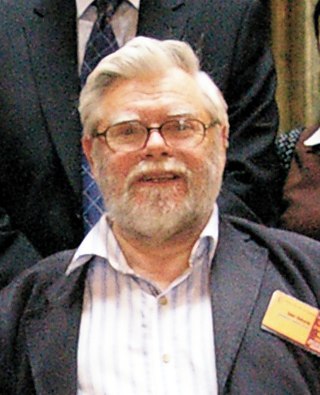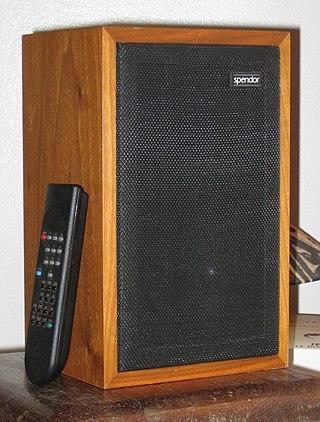Near Instantaneous Companded Audio Multiplex (NICAM) is an early form of lossy compression for digital audio. It was originally developed in the early 1970s for point-to-point links within broadcasting networks. In the 1980s, broadcasters began to use NICAM compression for transmissions of stereo TV sound to the public.

Kingswood is a constituency in South Gloucestershire represented in the House of Commons of the UK Parliament since 2010 by Chris Skidmore, a Conservative.

backstage.bbc.co.uk is the brand name of the BBC's developer network which operated between May 2005 and December 2010.

ITU-R 468 is a standard relating to noise measurement, widely used when measuring noise in audio systems. The standard, now referred to as ITU-R BS.468-4, defines a weighting filter curve, together with a quasi-peak rectifier having special characteristics as defined by specified tone-burst tests. It is currently maintained by the International Telecommunication Union who took it over from the CCIR.

BBC North (Group) is an operational business division of the BBC.

WMG, University of Warwick, is a UK-based research and education group combining collaborative research and development with education programmes working in applied science, technology and engineering. An academic department of the University of Warwick and a centre of the High Value Manufacturing Catapult, WMG was founded by Kumar Bhattacharyya in 1980 to help reinvigorate UK manufacturing and improve competitiveness through innovation and skills development.

Studio monitors are loudspeakers in speaker enclosures specifically designed for professional audio production applications, such as recording studios, filmmaking, television studios, radio studios and project or home studios, where accurate audio reproduction is crucial. Among audio engineers, the term monitor implies that the speaker is designed to produce relatively flat (linear) phase and frequency responses. In other words, it exhibits minimal emphasis or de-emphasis of particular frequencies, the loudspeaker gives an accurate reproduction of the tonal qualities of the source audio, and there will be no relative phase shift of particular frequencies—meaning no distortion in sound-stage perspective for stereo recordings. Beyond stereo sound-stage requirements, a linear phase response helps impulse response remain true to source without encountering "smearing". An unqualified reference to a monitor often refers to a near-field design. This is a speaker small enough to sit on a stand or desk in proximity to the listener, so that most of the sound that the listener hears is coming directly from the speaker, rather than reflecting off walls and ceilings. Monitor speakers may include more than one type of driver or, for monitoring low-frequency sounds, such as bass drum, additional subwoofer cabinets may be used.

MediaCityUK is a 200-acre (81 ha) mixed-use property development on the banks of the Manchester Ship Canal in Salford, Greater Manchester, England. The project was developed by Peel Media; its principal tenants are media organisations and the Quayside MediaCityUK shopping centre. The land occupied by the development was part of the Port of Manchester and Manchester Docks.
Sound-in-Syncs is a method of multiplexing sound and video signals into a channel designed to carry video, in which data representing the sound is inserted into the line synchronising pulse of an analogue television waveform. This is used on point-to-point links within broadcasting networks, including studio/transmitter links (STL). It is not used for broadcasts to the public.
Rogers is a British brand name of Rogers International Ltd, a subsidiary of Wo Kee Hong Holdings Ltd, a company based in Hong Kong that produces a variety of audio electronic products.
Analogue terrestrial television in the United Kingdom was originally the method by which the significant majority of viewers in the UK, the Channel Islands and the Isle of Man received television. Analogue terrestrial television broadcasts have fully ceased in the UK with Northern Ireland being the last region to have ceased transmission analogue terrestrial television broadcasts. Northern Ireland switched off the last analogue television signals, making all of the United Kingdom only capable of receiving digital television, in the early hours of 24 October, 2012. It has been completely replaced by digital terrestrial television and other non-terrestrial means as of the end of 2012.

A-weighting is the most commonly used of a family of curves defined in the International standard IEC 61672:2003 and various national standards relating to the measurement of sound pressure level. A-weighting is applied to instrument-measured sound levels in an effort to account for the relative loudness perceived by the human ear, as the ear is less sensitive to low audio frequencies. It is employed by arithmetically adding a table of values, listed by octave or third-octave bands, to the measured sound pressure levels in dB. The resulting octave band measurements are usually added to provide a single A-weighted value describing the sound; the units are written as dB(A). Other weighting sets of values – B, C, D and now Z – are discussed below.

Tudor Rickards is a self-published author of non-fiction and fiction, a business academic, and a scientist. He is Professor Emeritus at University of Manchester and formerly Professor of creativity and Organisational change at Alliance Manchester Business School. His fiction works include The Unnamed Threat: A Wendy Lockinge Mystery (2019), Seconds Out (2018) and Chronicles of Leadership (2016). His non-fiction includes Tennis Matters: A Leaders We Deserve Monograph (2015), Tennis Tensions (2015), The Manchester Method (2015) and The Double Houdini (2016).
KEF is a British company specialising in the design and production of a range of high-end audio products, including HiFi speakers, subwoofers, architecture speakers, wireless speakers, and headphones. It was founded in Maidstone, Kent in 1961 by a BBC engineer named Raymond Cooke (1925–1995).

New Broadcasting House (NBH) was the BBC's North West England headquarters on Oxford Road in Chorlton-on-Medlock, Manchester. The studios housed BBC Manchester, BBC North West, the BBC Philharmonic Orchestra and the BBC Religion and Ethics department. It was known as a Network Production Centre, the others being in Birmingham and Broadcasting House, Bristol.
BBC Redux was a BBC Research & Development system that digitally recorded television and radio output in the United Kingdom produced by the British Broadcasting Corporation. It operated from 2007 to 2022 and contains several petabytes of recordings and subtitle data. It is notable for being the proof of concept for the Flash video streaming version of the BBC iPlayer.

The LS3/5A is a small studio monitor loudspeaker originated by the BBC for use by outside broadcast vans to ensure quality of their broadcasts. The speaker concept set out transparent and natural sound as the goal, and the achievement of the end result is widely acknowledged.
Spencer Hughes (1924–1983) was an English audio engineer who worked at the BBC research department in the 1960s. He founded Spendor to manufacture loudspeakers incorporating results of his research.
Spendor is a British loudspeaker manufacturing company founded in 1969 by audio engineer Spencer Hughes (1924–1983) and his wife Dorothy. It is located in East Sussex. The name was derived from the first names of both.












